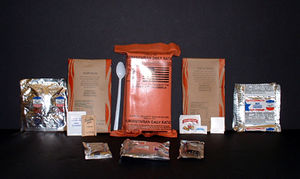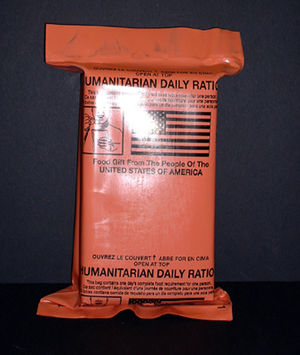Humanitarian daily ration
Humanitarian daily ration is the name for an emergency ration, with a long shelf-life,[1] intended to be used for refugees during natural diasters, or in conflict areas.[2]
The meals are designed to be able to survive being air-dropped, without a parachute.[3] This is safer for the refugees than parachuting large palletes of rations. And it prevents hoarding of the meals by a few individuals. The meals cost approximately 20 % the cost of a meal ready to eat.[4]
Initially the rations came in a yellow wrapper, but that was the same color as a antipersonnel cluster submunition The color was changed so civilians would not pick up a dangerous unexploded munition thinking it was food. <refname=QuartermastAlphabetSoup>Albin R. Majewski. The Alphabet Soup of Combat Rations, United States Army, Winter 2001. Retrieved on 2007-10-18. </ref>
| Shelf life | 36 months at 80 F |
| Weight | 30 ounces |
| Kilo Calories | at least 2200 per package |
| Protein content | 10-13 percent |
| Fat content | 27-30 percent |
| Carbohydrate content | 60 percent |
| Prohibited contents | Any animal products, except a limited amount of dairy products, below the limit that would cause a problem for a person with lactose intolerance. |
| Infant component | All rations contain a fruit paste, suitable for feeding to infants |
| Utensils' | All rations contain a spoon and a paper towel moistened with a non-toxic, non-alcoholic cleanser |
The rations were first used in Bosnia in 1993.[5]
References
- ↑ Judith McCallum. Humanitarian Daily Rations: Being Ready is Half the Battle, Defense Security Cooperation Agency, Winter 2001. Retrieved on 2007-10-18.
- ↑ 2.0 2.1 Technical Data for Humanitarian Daily Ration. U.S. Department of Defense. Retrieved on 2007-10-18.
- ↑ 3.0 3.1 Humanitarian Daily Rations. DCSA. Retrieved on 2007-10-18.
- ↑ 4.0 4.1 Operational Rations. United States Defense Logistics Agency. Retrieved on 2007-10-18.
- ↑ Memorandum for Correspondents. United States Department of Defense (August 2, 1995). Retrieved on 2007-10-18.


